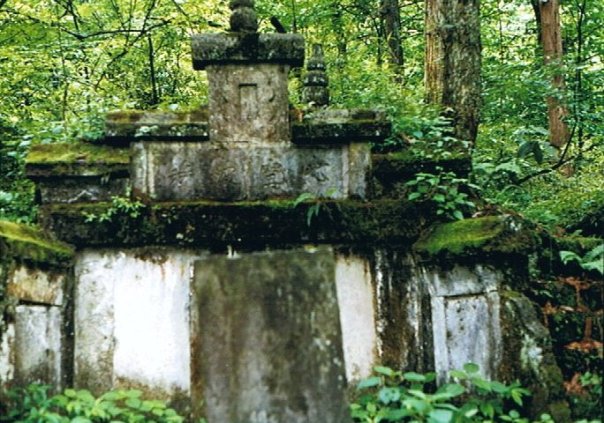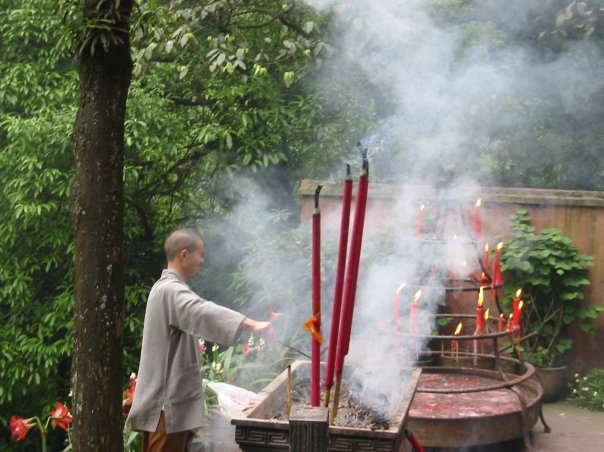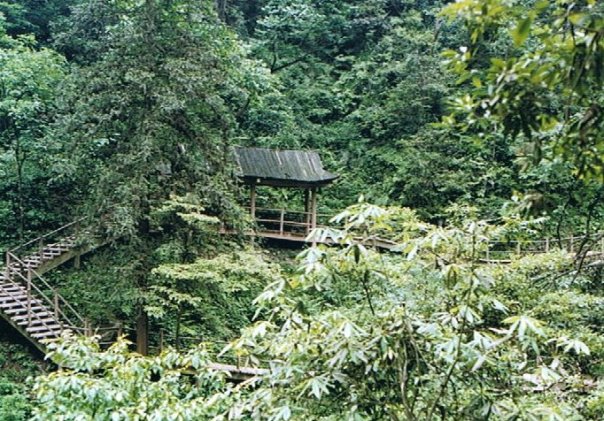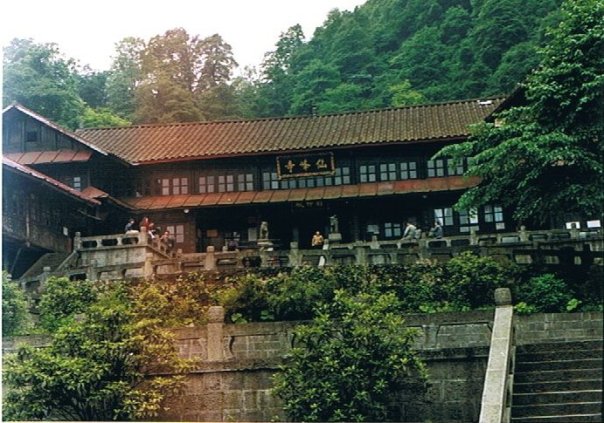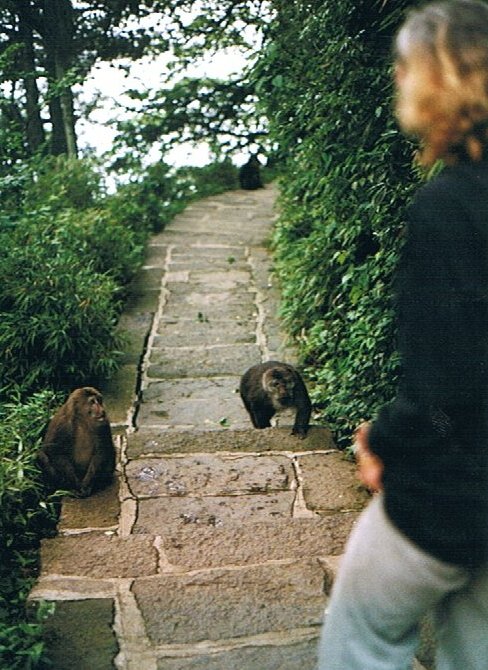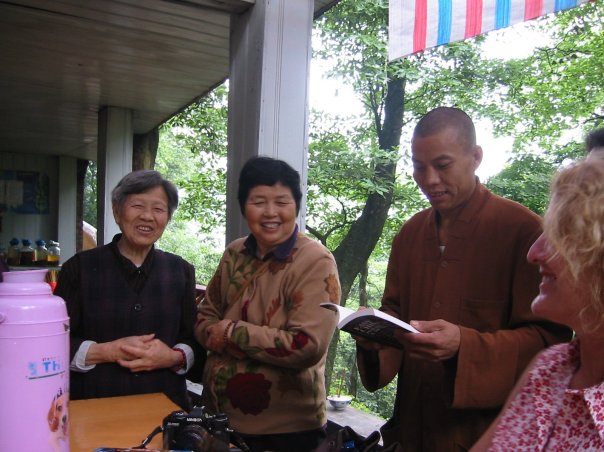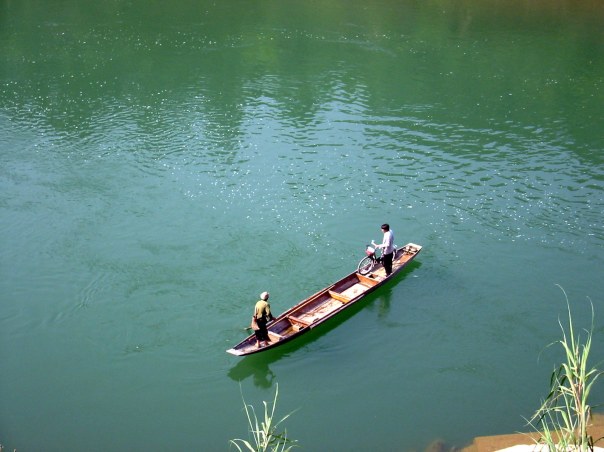Author Archives: Mulberrygrrl
Climbing Mt. Emeishan
A journey of 10,000 feet begins with one stair.
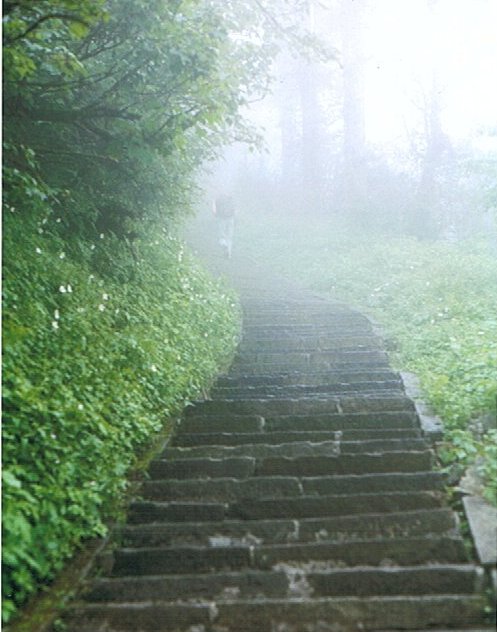
My knees were weak by the time my sister, Ellen, and I finally reached the monastery for the night. We paid our 120 yuan ($14) to a young saffron-robed priest for a room and two bottles of water, then fell back on our beds to recuperate before the communal dinner was served. Our open window looked out on a landscape as perfect as a classic Chinese watercolor—deep valleys and lushly forested peaks receding ever more distantly into a fog-enshrouded vanishing point. The impossibly small traveler of that picture is, in this instance, me, and the sense from the painting’s steep and winding trail that this seemingly endless journey can only be taken one step at a time is a truth that my knees have learned today.
More than 4,000 years ago the ever-pragmatic Chinese believed that heaven balances on the mountains, and that the surest way to get to heaven is up the highest peaks. Wanting to please his gods, every five years the ruler Shun climbed the four mountains defining the corners of his realm. Thus began the Chinese tradition of holy pilgrimages to mountaintops, and today, 4,259 years later, the Chinese word for “pilgrimage,” is still ch’ ao-shan chin-hsiang, translating literally as “paying one’s respect to the mountain.”
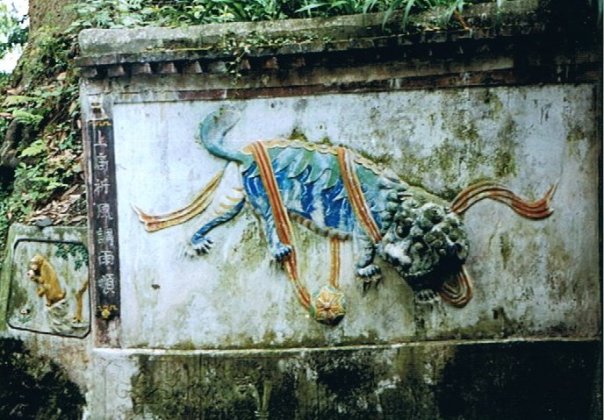
After eight straight hours of hiking I was beyond exhausted, but feeling pretty good about my secular pilgrimage. Today we’d climbed alternately beneath drizzling rain and scorching sun, were attacked by marauding monkeys, and still remained courageous every time we topped one hill, only to see the trail fall back down before ascending the next peak, meaning that our 8,500 foot climb would be more like 4,500 down and 10,000 up before we reached top.
Emeishan was Buddhism’s first foothold in China 2,000 years ago, and at its greatest time, during the Ming and Qing dynasties (from 1368 through the beginning of this century) there were 150 active temples on the mountain. Now, 40 years after the Cultural Revolution nearly wiped out Buddhism in China, the religion is making a comeback, and there are 300 or so resident monks and nuns in Emeishan’s 21 active monasteries. Chinese history is nothing if not long, and that longevity gives its people a patience that is foreign to us pipsqueak Americans. Tyrants and cultural revolutions come and go, but the holy mountain remains, and now reverent Chinese Buddhists are coming back to Emeishan on the same pilgrimage as 60 generations of their ancestors.
This evening our rest was hard-earned. The quiet was accentuated by an occasional closing door or the distant call of a cuckoo bird. The muffled footfalls of a monk’s slippers whispered down to me as he scuffled along a plank walkway above us. Somewhere close by water dripped. I raised my head to take in this bliss and saw, just outside my window, a plump little woman hanging her drawers on a line to dry. She bowed to me in Buddhist greeting, hands together and head bent, touching fingers to nose. I said, “Nihao,” Chinese for “hello,” and that was the cue for six more pint-sized seventy-somethings to poke their heads in and greet the newcomers. The women chattered at us as though we could understand every word, and shepherded us to the dining hall once the dinner gong sounded. From that moment on we were their Little Sisters.
After dinner Ellen and I settled into the mossy, stone-paved courtyard, perched on a weathered wood bench and gazing into a pool of languid koi. Incense burned in the bronze censer, sending up aromatic swirls of smoke that I imagine have risen from here since the 1100s. I can’t tell what parts of Hongchin Ping date from then, or from the period of its major construction at some unrecorded time during the Ming Dynasty between 1368 and 1644. Or from its recent renovation in 1790. I’m from Southern California, where the world’s oldest McDonald’s qualifies for inclusion in the National Registry of Historic Places, and any structure more than 100 years old seems to rate an entrance fee.
Hongchin Ping’s stone walkways are worn worry rock smooth from 600 or so years of slippers shuffling back and forth between prayers. Wooden steps concaved with age count back a tree’s rings, handrails trailed by moony fingers are as glossy as if varnished, red-painted walls show bare where shaved heads with 5:00 shadows rest back from benches. This is the kind of old we don’t see at home. I wonder, when America gets older, will we be more forgiving of age.
One of the Big Sisters joined us in the courtyard, and began teaching us a Buddhist chant, “om mani padme hum.” I was having difficulty with my lotus and proper finger placement, but was getting into the spirit when a strikingly handsome, gentle-eyed monk came from the temple, folded himself down next to me in full lotus, and joined the chant. Scrutinizing my posture from the corner of his eye, he turned to help me, pushing my knees, which were pointing up at a 45 degree decidedly unlotus-like tilt, down parallel to the bench. I could have laughed, were it not for the thrill of chanting alongside this exotic monk in a thousand year old monastery, the pain of my splitting adductor muscles, and incongruously impure thoughts of my new instructor.
Just a day before we were in a luxurious suite at the Crown Plaza Hotel in Chengdu, shopping at that city’s extensive antique mall and eating Sichuan Province’s notoriously firey and delicious cuisine. Chengdu is the capital of Sichuan, a province bordering Tibet and with considerable Tibetan influence. It’s said that Chengdu may be the oldest continuously inhabited city in the world, and it has much to offer tourists, but Ellen and I were eager to get to Emeishan for a three-day climb. On this morning we took a taxi to Chengdu’s Xinnanmen station, where we traveled two and a half hours by air conditioned bus to Emeishan, and then another short taxi ride to our starting point, Wannian Si Temple.
If you follow our footsteps, have no fear if you don’t speak a word of Chinese (neither of us knows any more than hello, goodbye, thank you, and where is…). The few tourists who travel this route are all going to the same place, and when a good-natured passerby sees your lost expression and says, “Emeishan?” all you have to do is nod “yes,” and they’ll lead you to your next handler. I’ve traveled from one edge of China to the other this way.
Arriving at Emeishan’s bottom-most temple, Baoguo Si, we paid our 120 yuan entrance to this UNESCO World Heritage site and began our climb. Alarmed by the number of hard-shoed tourists on the trail, we wondered if devoting a precious three days to Emeishan was a mistake. But after about an hour we left them all behind, finding that 99% of them were on day tours of the mountain. Chinese tourists are quickly making up for lost time and discovering the treasures of their own country. It’s only been a few years that residents of one province could travel to another without special government permission. Now that the travel ban has been lifted, easily accessed tourist sites are mobbed year-round. But the tourist industry has not yet spread to include an entire submarket of travel gear and tourist wear—male Chinese tourists often wear suits, even on hiking trails, and women stumble along behind in their high heels.
Beyond the mob Emeishan’s true character emerges. This is a 10,000-foot delight of wildlife, a protected site since the 10th century, when a government conservation bureau was established at the mountain’s oldest temple. Emeishan’s 45 square miles hold three major rivers, five climate zones from subtropical to alpine, towering karst cliffs and deep gorges, and more plant and animal species than in all of Europe. Yet for all its wildlife one can feel both frighteningly and ecstatically alone on Emeishan’s trails. On our first day, once past the day trippers, we saw no travelers but the hardy porters who, with Chinese patience, carry one several-hundred pound stone at a time up the mountainside for trail and temple repair, and two or three elderly Chinese pilgrims.
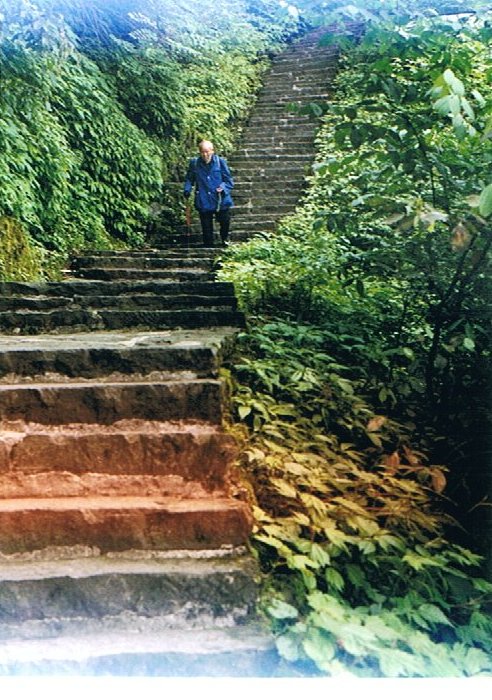
The densely wild forest crowds a narrow pathway that is dotingly tended by workers who live invisibly on the mountain. Stone stairs, firmly mortared, are so straight and steep that they disappear into the mist before the curve of the mountain takes them. Arched bridges and empty pavilions along the trail invite meditation. The hardiest pilgrims can make the entire trip in two and a half days, from Baogao Temple to the Golden Summit, where at sunrise they may view, if they’re lucky, Buddha’s Halo in refracted light. The most reverent, though, have been known to climb Emeishan on their knees, bowing at every step. The mountain’s 150 temples were thus situated with supreme respect to the pilgrims’ feng shui, so that prayers, meals, rest, and ritual could be partaken according to a natural order within the larger mountain organism.
I was surprised to find that our Big Sisters were indeed very hardy pilgrims. After the following morning’s breakfast they packed up their bags and deposited them on the monastery’s front steps, where a porter would tie all 11 bags to his back and resume the uphill journey. They also brought their own itinerant monk, who told them stories and led reverent discussion on the trail. I came to know him a little, and he is a trickster; curious, course, irreverent, entertaining the Big Sisters with his crazy wisdom. At an outdoor kitchen and dining area outside the monastery walls he interviewed me, pantomiming his questions or speaking slowly as I thumbed through my Chinese-to-English dictionary. Where am I from? What is my name? Would I like one of his cigarettes? Will I join them on their journey up the mountain?
I watched him. He told what I imagined were ribald jokes to the Big Sisters, and they all laughed loudly. Some of the Big Sisters exercised their legs while listening, their unselfconscious tai chi moves as natural as breathing. Then he would turn serious, and begin to lecture expertly with voice and gesture, with the women adding choruses of “ahhh” and “dui dui dui” when he hit the right chord. Without knowing what he said, I knew by his cadence and stops, and enchantment of the Big Sisters, that he was an expert orator.
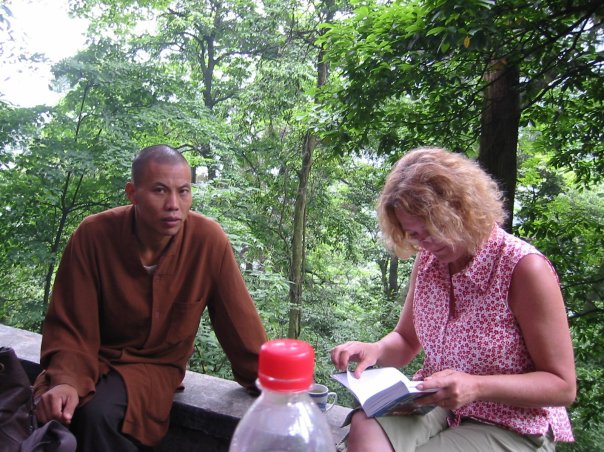
He is from Chongqing, a city 200 miles to the southeast, at the confluence of the Yangtze and Jaling Rivers. Chongquing is a major seaport, 1400 miles from the sea, and of such financial importance that seven years ago it was made a provincial-level municipality, much like a state. If you’re ever on a quiz show and asked to name the world’s largest city, you can technically and safely name Chongquing. Completion of the Three Gorges Dam will soon flood the municipality with goods passing upstream to new factories that will manufacture different goods to pass downstream and on around the Pacific Rim. Government officials are excited that this ancient city, historically known as Chungking, will be the doorway by which economic development will change Southwest China from a backwater to a powerhouse of progress.
Had my friend the itinerant monk been born in 2004 instead of 1964 he may have had more choices to escape destitute poverty other than to join the priesthood. I am thus glad he was born in 1964, and believe China is better for it too. The world needs more itinerant monks, and more crazy wisdom.
The Big Sisters, their crazy-wise monk from Chongqing, and the porter were off just after dawn, while Ellen hiked into the forest for some serious birding. Wide-ranging topography and ideal precipitation patterns make Emeishan one of the richest and most biologically diverse places on earth. There are more than 2300 species of wild animals, birds, and insects, and 500 species of plants, including myriad varieties of rhododendron and azalea, and dove tree, so named because of its spectacular asymmetrically-petaled white flowers. There are oakleaf butterfly, lesser panda, the quite rare golden monkey, Tibetan macaque, honey buzzard, and silver pheasant. Ellen saw none of them on her morning hike, though she spotted the rufous-bellied woodpecker, Japanese waxwing, blue-fronted redstart, and violet whistling thrush, all as glamorous as their names.
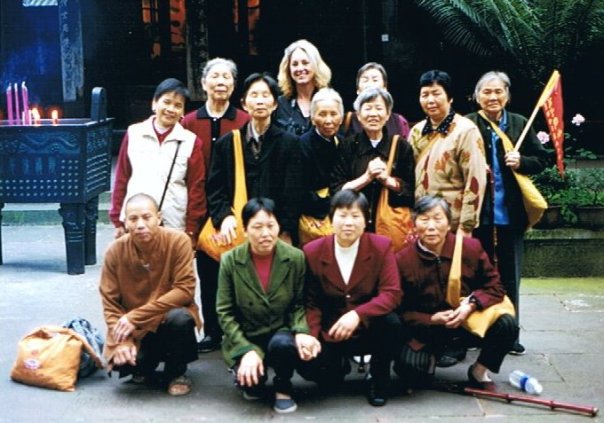
It’s interesting that there are so many species on Emeishan, as the mountain’s very formation is implicated in the late Permian age mass extinction. As the theory goes, an asteroid struck Earth on the opposite side of the world from Emeishan. Shock waves resonating at somewhere between 13,000 and 29,000 miles per hour ripped through the planet, creating an exit wound of fractured landscape, spewing lava and acid rain across Southern China. Ash darkened the skies. Oxygen was sucked from both air and water. The resulting mass extinction was the greatest die-off the world has ever known, and lasted more than 10 million years. Today, about 240 million years later, we tourists are blithely unaware of the mountain’s violent origin. Earth scientists, though, read the landscape like a great detective novel, and get all teary eyed talking about Emeishan’s trap volcanism and flood basalts.
Midmorning, Ellen and I hit the trail again. Our second day of trekking proved to be even more grueling, at 11 hours of climbing. But we didn’t know that yet. We were busy inspecting exotic blooming jack-in-the-pulpit, tiny pink corydalis, feathery astilbe, and even giant Himalayan lily, the first time I’d seen these magnificent fragrant blooms other than wrapped in pastel foil at Easter time. Many of the plants we saw are common in suburban landscapes in the U.S. I’ve inadvertently caused mass extinction of their relatives in my own garden.
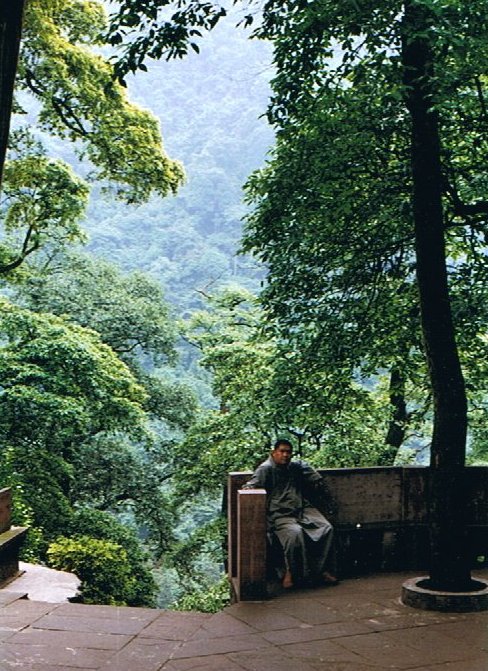
The morning belonged to just us, with no other human presence to remind us that we were not the first to discover these wonders. Only the occasional faint trails disappearing into heavy jungle reminded me that medicinal herb gatherers use the mountain as a main supply source. We were lost in our private wonderland when, rounding a curve, we encountered a band of macaques loitering alongside the trail, looking as dangerous as a gang of teenage boys might to a 60-pound sixth grader. The alpha male blocked our way, and sauntered toward us down the trail’s middle. Ellen, a wildlife biologist who first encountered macaques many years ago in Gibralter, there named Barbary apes, said, “Don’t look in his eyes! Stand still and look down.” He came between Ellen and me and the others began to close in. Ellen picked up a stick and walked slowly forward. That’s when a smaller macaque jumped her from behind, opening her backpack and making off with our precious bag of Dove chocolate bars that my husband had thoughtfully packed for us. They all clamored up the bank and set to ripping into the foil wrappers with their long fangs. We hoofed it, and it was another half mile before the screaming and chattering died down behind us. We really missed those Dove bars later, but were glad for our new personal version of the trickster Monkey King myth that the macaques gave us.
And who knows, these crafty Emeishan macaques could be the descendents of the original Monkey King, who after all was the allegorical fool, born from a rock in the form of a monkey, who went on pilgrimage to India to bring Buddhism back to China, and most specifically, to Emeishan, where Chinese Buddhism began. The Monkey King too was a trickster, taunting the laws of heaven, clever, resourceful, and belligerent. I’m afraid these monkeys need to further meditate on detachment and lovingkindness, though. Not to mention criminal activity. China has one of the lowest crime rates in the world, not counting cross-species crime. We walked cautiously, now carrying sticks to ward off macaques. The quiet was occasionally punctuated by birds, frogs, and the dreaded macaques, but we had no more trouble, and passed no one on the trail. On our entire journey we passed only six or seven other travelers, and no other Americans.
The higher we climbed, the mistier it became, till visibility was reduced to 20 feet or so, and we had to don our rain gear to keep dry. My hands were cold and I was getting quite tired, but we had no choice but to press on. The vegetation had changed from broadleaf to coniferous forest, and pine needles dripped cold water on me as we climbed. The birds had all disappeared by this time, intelligently escaping the cold and rain. For all that, it was beautiful and otherworldly. It began getting dark, and we were worried that we wouldn’t make it to the top. Facing a steep bank of stairs, I sat down and told Ellen that I couldn’t possibly go one step farther, and we’d have to turn back to the last monastery before black night set in. She offered to carry me, and in my humiliation I got up and continued on. Then, like sunrise after a long night, or blue sky at the end of a storm, the mist opened for a moment and we caught a glimpse of a monastery just ahead. We had made it. We were at Jieyin Hall.
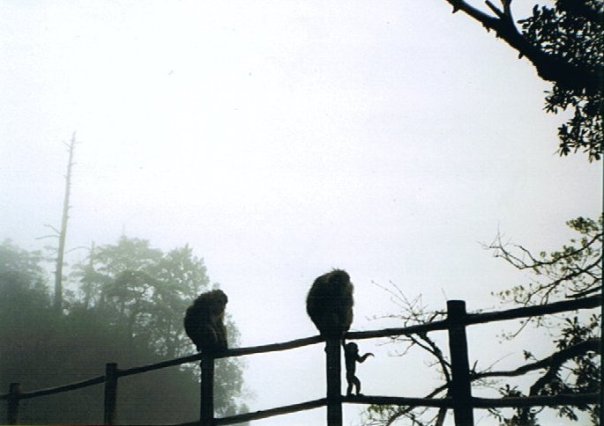 Dinner was long over, but a worker found us rice and vegetables, and then took us to our room, where we slept soundly. At sunrise we left, making the short walk to the cable car station that takes tourists to the Golden Summit. There, we took our obligatory photos of the sun rising above clouds that were far below us. It truly is a beautiful sight, but is endlessly hyped in tourist literature, and thus nothing more than what is expected.
Dinner was long over, but a worker found us rice and vegetables, and then took us to our room, where we slept soundly. At sunrise we left, making the short walk to the cable car station that takes tourists to the Golden Summit. There, we took our obligatory photos of the sun rising above clouds that were far below us. It truly is a beautiful sight, but is endlessly hyped in tourist literature, and thus nothing more than what is expected.
Before boarding the minibus we took a final walk along the cliffside trail we had climbed in darkness the previous evening. With nothing but a low rope between the trail and a sheer drop of several hundred feet, I was frightened in retrospect that we hadn’t plunged to our deaths. Gazing over the edge, I heard a familiar shriek, and looked up to see the first of our gang of Big Sisters coming up the trail, waving madly and calling out to us, their Little Sisters. They had hit out early that morning, and were on the last leg of their pilgrimage up Emeishan. I was thrilled to see them, but amusingly embarrassed that these grannies had made the same journey that just about killed me.
The Big Sisters gave us our final hugs and Buddhist wei gesture, and moved off toward the Golden Summit monastery to spend their last night. We headed toward the minibus for our hour and a half trip back down the mountain, then on to Leishan. On the trip down I watched the scenery zip by, and it was nothing more than thick trees and occasional distant views of farther mountain peaks. I marveled that just beyond those trees was a landscape so perfect that it is holy. The Chinese character for landscape is literally “mountain and water,” the mountain representing long life, and water as happiness. We were now at journey’s end, closer to heaven, our pilgrimage complete.
Speaking a Universal Language in Rural China
We wait in the shade of the ancient “wind and rain bridge,” studying its elaborately arched and painted ceiling. Soon my sister appears from up the hill, running down the cobblestone path that curves between weathered houses, a trail of giggling children streaming behind her like a kite ribbon. They had attached themselves to her long before we reached the village, after an adolescent water buffalo tender called out to the village from across the mountain that strangers were coming. The children were shy at first, but Ellen won their hearts by taking their photos and showing them the digital results.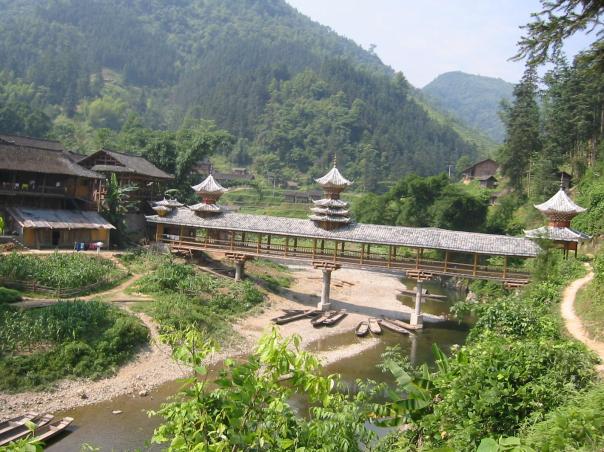
“What did he say?” I call to her. Our translator, who had accompanied her back to the village, calls back to us from up the hill. “He said, ‘My god you are kind!’” My husband and I laugh delightedly, pleased that we are able to show just a small token of gratitude to the old stranger who invited us into his home. It is, after all, a village so small, with houses woven so tightly together, that it could be one raw, multi-linear Frank Geary designed home, and us wandering uninvited through its hallways, peering into rooms.
“Us” kind? We like to think so, but after all, when was the last time we hailed a stranger on the street and invited him in, offered up an empty box serving as the only chair, and then asked him to join us in a lunch of vegetables from the fields we tended halfway over the next mountain? That doesn’t happen on our planet, which is Los Angeles, where produce comes from Whole Foods Market and where your house has to burn down in one of our annual firestorms before a neighbor invites you in. Nor is it the way of the rest of China, where my husband and I have been traveling for more than 20 years. No matter how close you become with most in the 92% Han majority, a home invitation is rare indeed. Not for any lack of hospitality, but because entertaining is traditionally done in restaurants, with hosts trying to outdo each other in offering the most elaborate and lengthy feasts.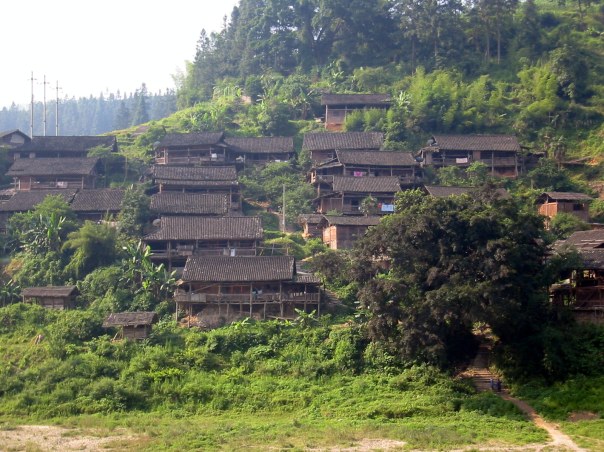
A more authentic experience
We’re in northwest Guizhou, 950 miles southwest of Shanghai, 625 miles northwest of Hong Kong, and several days by plane and car from either. Guizhou is the poorest of China’s provinces, and so remote that only recently have any but the hardiest traveled here. There is a saying that “in Guizhou, there are no three days that are clear, no three feet of land that is flat, and no one worth three pieces of silver.” The remoteness has hindered economic progress, but has helped maintain the authenticity of its many ethnic cultures. How long that will last is unknown, as the central government is driving development with new roads and airports being built with alarming speed.
Southeast of this tiny village by 300 miles is Guilin, one of the most beautiful spots on Earth. And also one of the most crowded. Guilin is everyone’s idea of postcard-perfect China—if you can see past the Disneyland-like atmosphere that has developed since China opened itself to tourism little more than a decade ago. Savvy travelers are now opting for Yangshuo, just downriver, as the new undiscovered, unspoiled Guilin. Except if Yangshuo isn’t Disneyland yet, it’s at least Venice Beach, with dubious venders and a slightly hipper style to the international tourists. Even that has its charm, but I opt for a more authentic experience. It makes traveling more difficult, and good pre-travel research imperative, but the rewards are far greater.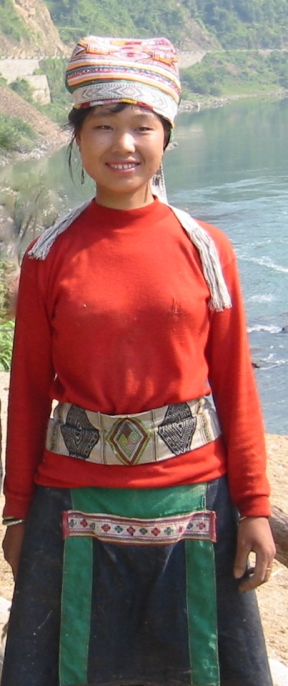
Here in Guizhou, minority Miao, Dong, Yi, Bouyei, Shui, Yao, and other small, indigenous cultures thrive with a vividness rarely seen elsewhere in the world anymore. Hospitality means being invited in to dine with newly-met families, sharing humble but generous meals that often include five or six dishes. You may even be offered a simple platform bed for the night.
We enter our new friend’s rough-hewn home with pleasure, and our translator is kept busy interpreting across two cultures curious about each other. He is of the Shui (schway) minority people, and in this country where just shy of 100% of the population speaks either Mandarin or Cantonese, he speaks or understands neither, speaking only the Shui’s ancient Zhuang-Dong dialect. But he knows the universal language of a shared beer between two men, and the cultural divide becomes a bit narrower when Patrick opens a beer from his backpack and passes it over.
The Shui “water people”
Just 286,000 of China’s one billion people are Shui. Shui means “water,” and the village of Bameng sits at the confluence of two rivers that flow beneath steep jungled mountains. On this warm spring day grandmothers and grandfathers sit in their doorways, or follow behind toddlers as they inspect every leaf or cricket. The rest of the village is at work, the women in their vegetable and rice fields over the next mountain, and the men out fishing on the river.
We’re on our way from Huangping to Danzhai, where we’re expected for lunch. The highway between those two small outposts in thinly-roaded Guizhou province is dotted with even smaller villages, with heavily traveled trails disappearing from the highway into the jungle, leading to yet farther villages. The rare car on this highway competes with young boys leading water oxen, and women in colorful native dress riding ponies on thickly embroidered saddles. When I see any that happen to be at a particularly picturesque spot I make the loud shriek from the back seat that our driver has come to recognize as a call to pull over, and Ellen and I go through our well-practiced routine of pulling out the camera and asking for a photo. The locals oblige, after which we exchange smiles, and maybe touch each other’s clothes admiringly, knowing that each of us wish for the other’s exotic life at that moment.
When I looked out the car window and saw the small collection of wooden houses that Joanne, our university student translator, taught me to recognize as a Shui village, I asked if there was a way to cross the river for a visit. We found a bridge just wide enough for the car, but found the road back along the river fit only for oxcart, and so made our way by foot to this small collection of 20 or so homes. Like so many others, the immediate entrance to Bameng is across an ages-old covered “Wind and Rain” bridge that’s adorned with raised pagoda-like pavilions terracing upward to a pointed top. The sides are open, and a bench runs the entire length on either side. This is where old villagers meet and wile away the hours while their grandchildren play nearby. Washed over by cooling breeze, I can’t think of a better way to spend an afternoon than sitting with them, watching the languid river beneath me carry fishermen downstream in their one-man canoes, where they toss their nets in full faith that they’ll pull dinner from the current, just as their fathers and grandfathers have done since establishing their first villages here by the Duliu and Longjian rivers. That was more than 1,000 years ago.

Shui traditions are intact
You can get an idea of the Shui people’s history by walking the length of a wind and rain bridge. Their ceilings are often painted colorfully in Shui legends, wars, customs, and natural environment. Shui shamans are still charged with passing down their histories in elegant poetry, and most Shui people in Guizhou’s villages adhere to elaborate traditions in their weddings, funerals, and other rituals and festivals. Just as I experienced years ago in Bali, you can’t travel very far in Guizhou without coming across a bright and happy festival. Nearly 50 major festivals a year take place among different cultures in Guizhou. To this day it is one of the only times that young men and women can meet and court, since work is constant. At one festival I attended, I was charmed by a traditional dance performance that had coy girls toying with hopeful boys in a mating ritual that crosses nearly every cultural boundary. But a young girl’s displayed helplessness is a luxury in China and for the Shui, each of whom must contribute to the livelihood of the village.
Even when there is no festival you’d think people are on their way to one. As I sit on the bridge waiting for Ellen I watch a stream of Shui women walking home from the fields. Just as you and I know a punk from a preppy, and a hip hopper from a hipster by their dress, here the cultures are even more accurately defined by clothing in styles that have not changed in generations. The Shui women’s cobalt blue blouses are sewn from a cloth they weave themselves. These blouses and even their black slippers are then embroidered with dazzling flowers and birds. Those with babies wear black velvet baby carriers that are fully covered in hand-stitched embroidery that anywhere else would be framed for prime wall space.
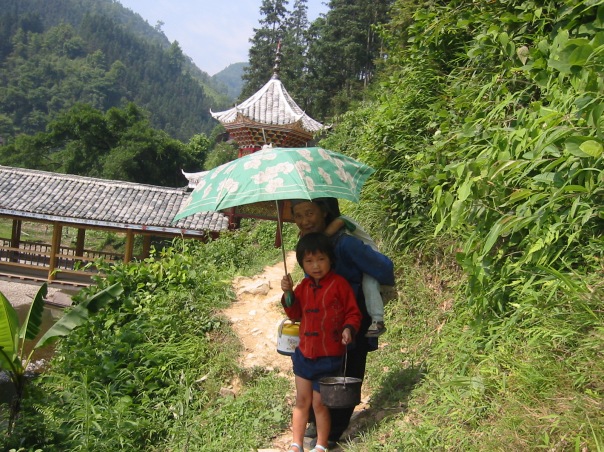
The anxious pacing of our chain-smoking driver tells us that we can’t stay for lunch. We and our host aren’t the only ones disappointed. So are the villagers gathered at the front door, which has become a frame of faces, from the mischievous bare-tummied boys peeking in from the sides, to the unsmiling but not unfriendly elders who watch us like a Discovery Channel documentary. As I rise from the blanket our host has spread for us, all the women in the doorway turn their eyes to my chest. We say our goodbyes and walk out into the hot sun. The women are laughing and chattering now, and one of the older ones reaches out and cups my left breast. “Ohhhhhhhh!” she nods approvingly. “I wish I could give them to you,” I say, and Joanne translates, to the delight of the crowd.
They all start to wander off, back to their own doorways, or chasing down grandchildren who are now trying to torment the flocks of geese who share the shade with dogs and pigs. We start back down the path to the wind and rain bridge, and farther on to our car, and the waiting government officials in Danzhai who have planned another special banquet for their esteemed guests from abroad. Just before the bridge we reach the house that serves also as the convenience store. Patrick asks at the open door for two more beers, and then invites Ellen to take them back to our new friend, who seemed to enjoy his first one so much.
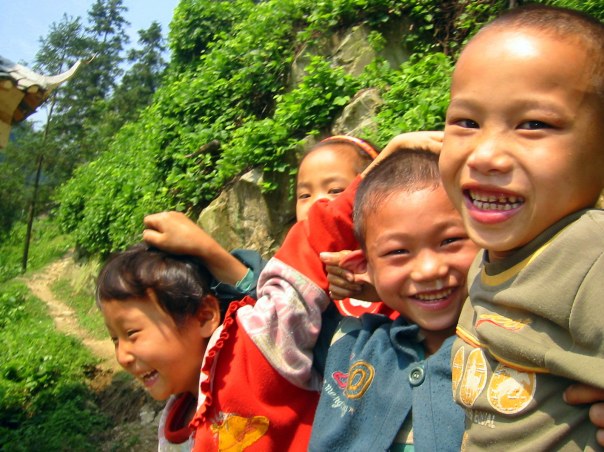 When Ellen and Joanne return, and we all hear the Shui gentleman’s charming “My god you are kind” response, we reluctantly resume our journey, vowing to spend a few days in this homey village on our next trip back. Then, only after leaving does Joanne tell us that we are the first foreigners the young children have ever seen.
When Ellen and Joanne return, and we all hear the Shui gentleman’s charming “My god you are kind” response, we reluctantly resume our journey, vowing to spend a few days in this homey village on our next trip back. Then, only after leaving does Joanne tell us that we are the first foreigners the young children have ever seen.
Few other foreigners
While it becomes less and less common to find remote corners of any country that have not seen foreigners, you can still find them in China if you are very lucky and very adventurous. And even if you aren’t the first visitor there, you may be the only one during your visit. During our nine days in Guizhou we saw no other Americans, and less than a half dozen foreigners of any kind. Apparently there was a travel show on French TV several years ago that caused a minor uptick in tourism, but otherwise it is only the backpacking twentysomething or lifelong explorer who you will meet there. The Guizhou countryside is not ready for tourists who demand comfort. Hotels in the small towns are primitive, and food is far from what you’d find in your local Chinese restaurant. If you wander into a typical restaurant there you’re just as soon to see fried larvae as fried rice with dinner, and eggs pickled rather than poached for breakfast.
However, you can have both adventure and some degree of comfort if you plan a tour with one of the new China travel specialists. Warrior Tours offers cultural tours through Southwest China, as does China Highlights and ctrip.com. The official China tourist agency is China Int’l Travel Service (CITS), and every major Chinese city, and many minor cities, has a CITS office. Their website, http://www.4panda.com, offers good advice and travel planning, including several 4-15 day tours around Guizhou’s ethnic villages. All these travel specialists can provide comfortable, air conditioned cars, professional drivers, decent hotel and meal accommodations, and unique village and festival visits.
My own favorite trip planning method is to contact a university or language school near my destination and have them help me custom design a trip. For this Guizhou journey I was lucky enough to find the head of an English language school in Guiyang, the capital of Guizhou. He was also head of the local disabled person’s association. He found us a student translator/guide, and arranged for us to visit disabled childrens’ schools in the poorest areas to deliver American-donated supplies that we brought over with us. The English language children’s books were a special hit. Even deep in this remote corner of China, barely touched by the outside world, English is a required course for all children lucky enough to go to school.
If you’re lucky enough to get to Guizhou, look for Bameng. You won’t be the first Americans these children have seen, but you might be the second.
